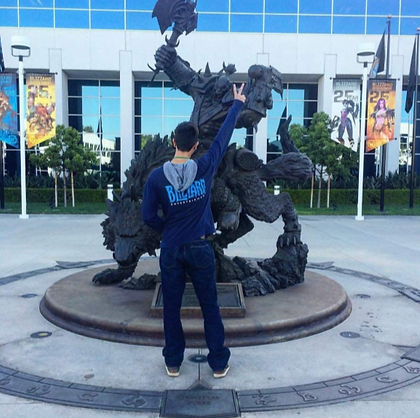

.png)
"Get into the mindset of receiving and analyzing feedback you’re
given. As a game designer, it's crucial that you learn how to process feedback,
learn what the root of the problems are, and go about solving from there. After you learn how to utilize feedback, an equally important part is
learning to let go of your original design."
Hear Matthew talk about his career in game design and how got there!

Last day of my Blizzard Internship!
MILESTONES
My career roadmap has been somewhat defined.
It all started when my mom bought a Nintendo 64 when I was a toddler and used it as a reward for learning. Whether it was potty training, learning my letters and numbers, or doing chores around the house, video games were what I looked forward to.
When I was around 9, I moved on from Super Mario 64 to the Playstation 2 and fell in love with a game called Kingdom Hearts. From the moment I saw the opening cutscene, I knew that making video games was something I needed to do.
Throughout grades 7-12, I started experimenting with whatever design tools I had available to me. This was mostly making
sprite based animations or re-skinning textures in a Super Mario 64 emulator I found online (2008 didn’t have much in the way of free game engines yet). I also started playing World of Warcraft extensively.
Throughout grades 7-12, I started experimenting with
whatever design tools I had available to me. This was mostly making
sprite based animations or re-skinning textures in a Super Mario 64
emulator I found online (2008 didn’t have much in the way of free game
engines yet). I also started playing World of Warcraft extensively.
I got accepted to UCI’s Computer Game Science major and
quickly joined the on campus “Video Game Development Club” which
allowed me to get some real hands on experience developing actual
games.
Between my Junior and Senior year, I was accepted into
Blizzard’s Game Design Internship on the World of Warcraft team -
basically achieving one of my most sought after dreams and securing a
stepping stone into the industry.
After graduating, I began job searching and found my now current position at Cryptic Studios working on the Magic the Gathering
MMOARPG as a Content Designer.

EXPERIENCE
Here are my extracurriculars relevant to this pathway
DURING MY HIGH SCHOOL CAREER
Independent game design / animation research and practice
Honestly, playing games actively is a requirement
DURING MY COLLEGE CAREER
Multiple years at UCI’s Video Game Development Club
Blizzard Game Design Internship
CAREER
What I'm currently doing/hope to do
Currently I’m working as a Content Designer on the Magic the Gathering MMOARPG, “Magic:
Legends”. This game is currently still in development as of 2020, but as a Content Designer,
my job usually consists of meeting with multiple disciplines (like Artists, FX, Level Design) to
discuss the weekly (or for some projects, daily) tasks that need to get done to make our game
come to life. Once all the meetings are done, it's back to my desk to work with our engine on
the level I’m assigned.
ADVICE
How to maximize my time in high school?
Advice #1: Take advantage of the free tools available to you. Unity and Unreal are both extremely powerful game design engines which are completely free! There are also easier to use ones like RPG Maker.
Advice #2: Take some time to learn different fundamentals of game design. There are plenty of YouTube channels and videos describing what exactly makes different designs good and bad. Being able to recognize these principles and discuss them will put you miles ahead of the competition.
Advice #3: You don’t have to go into Computer Science to work in video games! Aside from the obvious pathways of Programming and Art, I’ve seen the need for creative writers, sociologists, community managers, and even history majors have found their way in.
Advice #4: Get into the mindset of receiving and analyzing feedback you’re given. As a game designer, it's crucial that you learn how to process feedback, learn what the root of the problems are, and go about solving from there.
Advice #5: After you learn how to utilize feedback, an equally important part is learning to let go of your original design. Nine times out of ten, your first design isn’t going to be the one that ends up as the finished product. Iteration is a vital part of the process, and it doesn’t mean your first design is poor!

.png)



